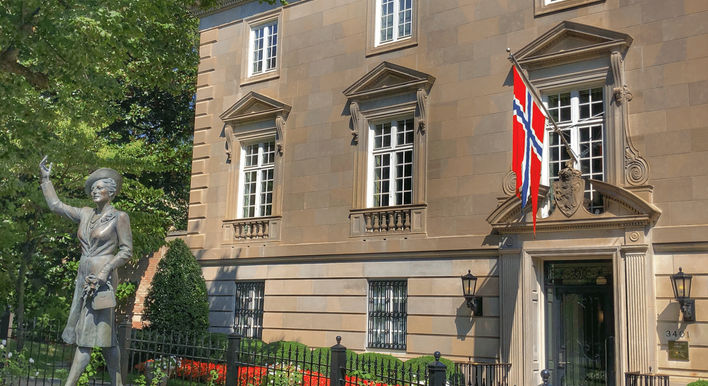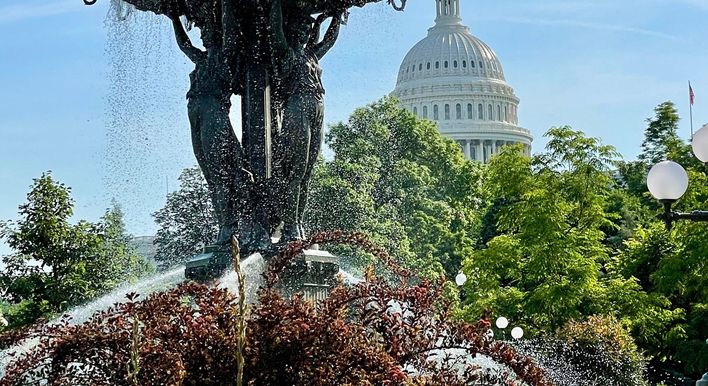The events of January 6, 2021 were not the first time our Capitol has seen invasion and violence. Sitting atop a small hill, this living symbol of the first branch of our government is a natural target for those choosing destruction over discourse. The following summarizes chaos wreaked on the Capitol since its opening in 1800.
A tour we think you'll love
Destroy and Lay Waste
The first attack, and by far the most destructive, on the Capitol is well known. On August 14, 1814 British ground and naval forces invaded Maryland and marched to Washington. The goal of the British was not to conquer the country and return the United States to its status as a colony. Rather their orders were to “destroy and lay waste” to the city in retribution for the American attacks on Canada. The attack was a complete rout of American forces. British troops arrived at the Capitol in the evening. They piled furniture in multiple places, poured on some gunpowder, then added fire. Both chambers were completely destroyed as was the Supreme Court and the Library of Congress, both being housed there at the time. The latter providing much of the fuel for the conflagration. The British then went to the White House, ate the president’s dinner, drank his wine, stole some souvenirs, and lit the place ablaze. The British then burned the Treasury and War and State department buildings. The Americans set fire to the navy yard so ships and munition would not fall into enemy hands. The British were in the city for all of twenty-six hours. The humiliation of a ransacked capital city is spun in our history as a minor setback preceding the glory three weeks later of the Battle of Baltimore where we continue to recall bombs bursting midair and seeing our flag still there.
Rock Em Sock Em Congressmen
Perhaps the violence in the Capitol that resembles the January 6 insurrection are the large number of fights between Members in the run up to the Civil War. Here the violence was not a foreign invasion as above, nor from political terrorists or persons with mental illness described below. Rather the seventy incidents of fights, brawls, beatings, bullying, drawn guns and knives, and a duel represent the same cultural strife and lack of reasoned discourse experienced today. The best known of these is the beating of Sen. Charles Sumner (R-MA). During debate on admitting Kansas as a state, Sumner mocked Sen. Andrew Butler’s (D-SC) position on the issue as taking “a mistress . . . who, though ugly to others, is always lovely to him; though polluted in the sight of the world, is chaste in his sight—I mean, the harlot, Slavery.” Butler was not on the floor to respond. Later that day Butler’s relative Rep. Preston Brooks (D-SC) came upon Sumner working at his desk and savagely beat him with a cane. Both men immediately became heroes to their causes. Brooks was censured, resigned, and immediately reelected. Sumner recovered and served eighteen more years.
Ivy League Bomber
Unabomber Ted Kaczynski was not the first Harvard member to choose bomb making as a vocation. In 1906 Eric Muenter was teaching German at Harvard University when he poisoned and killed his pregnant wife. Muenter escaped capture, changed names and took a teaching position at Cornell University. It was there he joined the German government’s spy service. On July 2, 1915 Muenter entered the Capitol to leave a bomb in the Senate chamber. Finding the door locked, he placed it under a telephone switchboard in a reception room. He then went to Union Station and bought a ticket to New York. The bomb detonated late at night and there were no injuries. Once in New York he placed a bomb on the SS Minnehaha, a munitions ship headed to England. The bomb did little damage (the Minnehaha was later sunk by a German U-boat). That same day he traveled by train and taxi to the home of J.P Morgan Jr, a financier who helped Britain pay for its war against Germany. Muenter shot Morgan, but the wound was superficial. Morgan’s butler beat Muenter unconscious with a chunk of coal. Muenter was arrested but took his own life the next day.
Good Catch
Only Members are allowed to speak in the House chamber. But on December 13, 1932 Marlin Kemmerer of Allentown, Pa. thought differently. Standing in the gallery he brandished a pistol and interrupted debate on a Post Office appropriations bill saying he wanted to talk about the state of the economy. Members fled from the floor. All except Melvin Maas (R-MN). Maas was a WWI veteran and a Marine Reserve officer. Maas talked from the floor with Kemmerer and convinced him to drop the loaded, cocked pistol which he fortunately was able to catch. Kemmerer was arrested. Maas continued to serve in the House until called back to the Marines for WWII. He served in the Pacific where he lost his sight in battle. He retired from the Corps as a major general.
Good Seats
The south House gallery is a spot tour guides often take groups to either see the chamber in session or, if it’s not, explain what takes place there. On March 1, 1954 the gallery was the site of a terrifying assault on the House. Speaker Joe Martin was presiding over a rollcall vote on a farm migrant worker bill when four Puerto Rican nationalistsunfurled a Puerto Rican flag, shouted “Viva Puerto Rico!,” and with handguns fired some thirty shots onto the House floor. Five Members were wounded, all survived. Others in the gallery wrestled the three men and one woman to the ground. They were arrested and tried in Washington. The men received seventy-five year sentences, the woman 50 years. In 1978 and 1979 President Carter commuted their sentences. They returned to Puerto Rico to a hero’s welcome.
You don’t need to be a weatherman to know which way the wind blows
On March 1, 1971 a bomb exploded in a Senate restroom causing $300,000 of damage. The devise was planted by the radical militant Weather Underground organization in response to the US invasion of Laos. As a result of this bombing metal detectors were placed at the chamber’s entrances. This was a part of a string of Weather Underground Organization bombings of government buildings that included the Pentagon and State Department. No one was killed as there was advanced warning. But three members of the group died in 1970 as they tried to build a bomb.
Ladies Night
November 7, 1983 marked the last bombing of the Capitol. Fortunately that evening business concluded earlier than expected. For late that night a massive explosion ripped through the second floor of the Senate. It tore the door off the Majority Leader’s office and blew a hole through the wall of the Republican cloakroom.
The Armed Resistance Unit claimed responsibility saying it was retaliation for the US invasion of Grenada and Lebanon. After a five year investigation, six people were arrested. Three were not tried as they were already serving lengthy sentences. Three women were tried and received sentences from 14 to 80 years. Two are still alive. This bombing resulted in more restrictive security measures. The lobby outside the Senate chamber was closed permanently, metal detectors were placed at all building entrances, and Congressional staff were issued ID cards.
Capitol Tragedy
Untreated mental illness was the cause of tragedy on July 24, 1998. Russell Eugene Weston Jr ran past a security checkpoint in the House and fatally shot Capitol Police Officer Jacob J. Chestnut, Jr. Weston then went to the office of the House Majority Whip where he exchanged fire with Detective John M. Gibson. A tourist was wounded in the crossfire. Gibson was mortally wounded but his actions allowed fellow officers to subdue Weston. A House and Senate concurrent resolution authorized Chestnut and Gibson’s bodies to lie in honor in the Capitol Rotunda. They are buried at Arlington National Cemetery. Weston said he was protecting the country from destruction by cannibals and an unnamed disease. He was diagnosed with schizophrenia and found incompetent to be tried. He is indefinitely confined to a federal hospital.
January 6, 2021.
The Capitol itself is a symbol of open government. Unlike the White House and parliaments of other countries, there is no fence around the Capitol. It is truly the people’s house and its grounds so gracefully planned by Fredrick Law Olmstead are open for public enjoyment and assembly.
The full impact of the domestic terrorist attack on the Capitol is not yet known. But the results may be profound. In the last years increased security measures have led to a decrease in access to and the attractiveness of public space in Washington. A temporary fence now surrounds the fifty-eight acre grounds. There will be calls to make it permanent. So, the Capitol may yet face its greatest test of strength: After surviving burning, bombings, shootings, and invasion, is it resilient enough to keep its openness? If not, the terrorists will have surely won.







